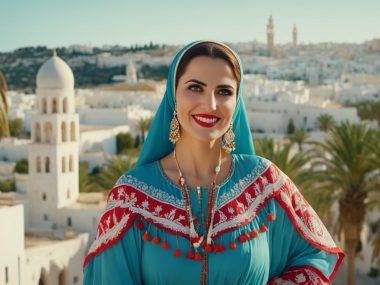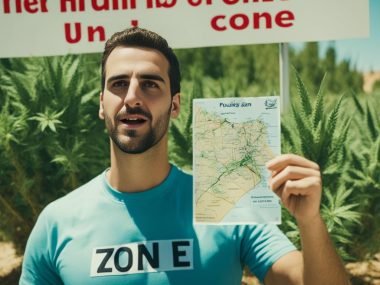Did you know Morocco, Algeria, and Tunisia have low greenhouse gas emissions? These countries are in North Africa and are close to each other. They share a rich culture and face similar environmental challenges.
Morocco, Algeria, and Tunisia have strong connections because of their history, geography, and economy. They have less pollution compared to some European countries. But, they struggle with problems like not having enough water. Each country has its way of dealing with these issues. For example, Morocco is good at managing waste and farming without chemicals. They can produce their own meat and milk. Tunisia is also doing well in farming organically. Algeria uses very little chemical fertiliser in farming. This makes each of them special in their efforts to protect the environment.
Key Takeaways
- Morocco, Algeria, and Tunisia exhibit moderate greenhouse gas emissions.
- All three countries face significant environmental challenges such as water scarcity.
- Morocco excels in waste management and organic farming.
- Tunisia has expanded its certified organic farming areas significantly.
- Algeria uses the least amount of fertiliser among the Maghreb countries.
Shared History and Colonial Influence
Morocco, Algeria, and Tunisia share a history touched by colonial rule. This time influenced their politics, society, and culture. Their modern identities still show these effects today.
French Colonisation
French colonisation deeply affected Morocco, Algeria, and Tunisia. The French set up systems that still shape these countries. Things like education and roads got French touches, mixing into their national ways.
Struggle for Independence
Independence battles were key for these North African countries. They showed great strength in freeing themselves. This bravery brought them closer and built pride that still shows.
Today, this shared past influences their politics and society strongly. It reminds them of what they have overcome together.
Cultural Influences in the Maghreb Region
The Maghreb region has a deep cultural background. Its history and connections make it unique. This covers Morocco, Algeria, and Tunisia.
Arabic Language and Islam
Arabic is vital in the Maghreb region. It brings people together in Morocco, Algeria, and Tunisia. Islam shapes daily life and rules in this area too.
Berber and Andalusindian music Heritage
Berber culture is also key. It shows in language, traditions, and connecting to roots. It makes the Maghreb’s history richer.
Andalusian music adds to this mix. It enriches the shared culture and pride of the nations.
Geographic Proximity and Climate
The countries of Morocco, Algeria, and Tunisia are close to each other in the Maghreb region. This closeness creates a mix of weather conditions and natural scenes. Their different lands greatly affect the Maghreb’s weather.
Mountain Ranges and Deserts
The Maghreb is known for its range of landscapes. It has mountains and big deserts. The Atlas Mountains stretch through Morocco, Algeria, and Tunisia. They offer a stark difference to the large Sahara desert. These mountains are important because they change the weather and create different living areas.
Mediterranean Coastlines
The Mediterranean coast is also key to the Maghreb’s weather and living spaces. It goes along all three countries. This coast is famous for its mild Mediterranean weather. The coastal spots have special sea and land living areas. They add to the area’s many types of life and make it stand out in North Africa.
Political and Socio-Economic Challenges
The Maghreb countries, including Morocco, Algeria, and Tunisia, face tough socio-economic issues. High unemployment rates are a big problem, pushing them towards economic changes. They are working hard to achieve sustainable development goals for a brighter future for their people.

Unemployment and Economic Diversification
Unemployment is a big issue in Morocco, Algeria, and Tunisia. It affects political stability and brings people together. They are trying to diversify their economies to solve this. For example, Morocco is focusing on renewable energy, and Algeria on its non-oil sectors. Tunisia is growing its tech industry for more jobs. Their aim is to rely less on old sectors, making the economy stronger.
Sustainable Development Strategies
The Maghreb countries are focusing on sustainable development to beat socio-economic challenges. Morocco’s Green Plan and Algeria’s Renewable Energy Programme are just two examples. Tunisia also has a strategy for sustainable development. They want to grow economically while keeping the environment safe. Doing this will help future generations.
Economic Activities and Trade Relationships
Morocco, Algeria, and Tunisia boost their economies together. They use natural resources and locations well. Their cultures also help their economies grow.
Hydrocarbon and Mining
Algeria makes a lot from hydrocarbons, helping its economy a lot. Morocco and Tunisia are big on mining. They mine things like phosphate and zinc. This mining meets local needs and helps them sell goods abroad, growing their industries.
Tourism Industry
Tourism is key for Morocco, Algeria, and Tunisia. Morocco draws crowds with its old towns, deserts, and beaches. Tunisia has ancient sites and lovely beaches that bring tourists from everywhere. Algeria’s festivals and nature spots are attracting more visitors. Tourism boosts their economies and trade with other countries.
Traditional Cuisine and Culinary Practices
The Maghreb cuisine shows the rich culture of Morocco, Algeria, and Tunisia. Its dishes mix many influences but keep their unique taste. Dishes like couscous, tagine, and brik are well-known. They use local spices like saffron, cumin, and coriander.
In Morocco, the dish tagine is cooked in a special pot. This slow-cooking blends the meat, veggies, and spices well. Algeria’s chakhchoukha, a stew, shows the country’s simple beauty. Tunisia’s famous for harissa sauce. It’s a spicy mix that adds zest to many meals.
Here’s a look at some key dishes:
| Country | Dish | Main Ingredients | Cooking Method |
|---|---|---|---|
| Morocco | Tagine | Meat, vegetables, dried fruits, spices | Slow-cooked in a tagine pot |
| Algeria | Chakhchoukha | Dough, meat, vegetables | Simmered in a stew |
| Tunisia | Brik | Thin pastry, egg, tuna, capers, harissa | Deep-fried |
Food in the Maghreb is about community and tradition. Meals bring people together. The cuisine of Morocco, Algeria, and Tunisia connects to their culture. It highlights the Maghreb’s rich history and shared stories.
The Role of Agriculture in North African Economies
Agriculture is key in North Africa’s economies. The area mainly focuses on farming. There is a big move towards growing food for themselves and organic farming in Morocco, Algeria, and Tunisia. This helps feed their people and makes their economies stronger.
Food Self-Sufficiency Challenges
North African countries want to grow enough food, especially grains, by themselves. Morocco is doing well with meat and milk but not grains. They all work hard to feed their growing number of people. Feeding everyone is very important for their economies.
Organic Farming Initiatives
Organic farming is getting big in North Africa, especially Tunisia. More land there is now used for organic farming. This makes food healthier and farming better for the planet. It also helps with soil, living creatures, and has less bad effects on nature. This is good for their economies, too.
| Country | Efforts in Food Self-Sufficiency | Organic Farming Initiatives |
|---|---|---|
| Morocco | Self-sufficiency in meat and milk production | Increased focus on organic products |
| Tunisia | Growing efforts to become grain self-sufficient | Significant increase in certified organic lands |
| Algeria | Challenges in grain production | Adopting sustainable and organic farming practices |
Environmental Issues and Management
The Maghreb area faces tough environmental issues. Lack of water and waste problems make things harder. But, there’s hope with renewable energy steps towards lasting growth.
Water Scarcity and Waste Management
Water is getting rare in Morocco, Algeria, and Tunisia. They are trying different ways to solve this. From smart water use in Tunisia to Morocco’s careful resource use, team work and new tech are key. Waste issues also need quick fixes. Cities need better systems and rules to handle waste.
Initiatives in Renewable Energy
Renewable energy is a big deal in the Maghreb. Morocco is ahead with projects like the Noor Ouarzazate Solar Complex. It shows how solar power is a big part of their energy plans. Algeria and Tunisia are also trying wind and solar projects. They see the worth of clean energy for their needs. They work together and with others to beat environmental issues and go green.
To sum up, water and waste issues are big problems. Yet, the Maghreb’s push for renewable energy is a forward step. This move towards better environmental care is hopeful.
Social and Political Movements
The Maghreb region includes Morocco, Algeria, and Tunisia. It’s known for important social movements and political shifts recently. The Arab Spring was a key event there.
2011 Arab Spring Impact
The Arab Spring started in 2011. It was a big wave of protests that changed Maghreb’s politics a lot. In Tunisia, it caused President Zine El Abidine Ben Ali to lose power. He had been in charge for over 20 years. This event sparked more movements in the region for democracy and political change.
Recent Political Developments
Since the Arab Spring, Morocco, Algeria, and Tunisia have seen big political changes. Tunisia is moving towards democracy with free and fair elections. This has made its politics more stable. Morocco, under King Mohammed VI, made constitutional changes to share power more and encourage political involvement. Also, Algeria had huge protests in 2019. These made President Abdelaziz Bouteflika resign after 20 years. These changes show the region’s efforts toward meeting social demands and gaining stable politics.
What Do Morocco Algeria And Tunisia Have In Common?
Morocco, Algeria, and Tunisia share a deep bond. They have shared heritage and similar traditions. These are rooted in their history and culture. These nations have a special identity in the Maghreb region.
They mainly follow Islam and speak Arabic. This strengthens their connection. Their culture has evolved together and separately over centuries. Their architecture, music, and crafts show their shared culture.
They are close to each other in location. They share the Atlas Mountains, Sahara Desert, and a big coastline. These shape their land, culture, and economy. They all work on saving water and using green energy.
They are working on looking after the environment and growing economically. These efforts show they want a sustainable future. They all focus on fixing their environmental problems together.
Below, see a table that shows how Morocco, Algeria, and Tunisia are alike and different.
| Aspect | Morocco | Algeria | Tunisia |
|---|---|---|---|
| Language | Arabic, Berber | Arabic, Berber | Arabic |
| Religion | Islam | Islam | Islam |
| Geography | Atlas Mountains, Sahara Desert, Mediterranean Coast | Sahara Desert, Atlas Mountains, Mediterranean Coast | Mediterranean Coast, Atlas Mountains |
| Environmental Issues | Water scarcity, Waste Management | Water scarcity, Renewable Energy | Water scarcity, Organic Farming |
This shows how closely Morocco, Algeria, and Tunisia are linked. It confirms their unity in North Africa.
Shared Languages and Dialects
Morocco, Algeria, and Tunisia share languages and have many dialects. These dialects and Berber languages help shape their cultures.
Standard Arabic vs. Regional Dialects
Standard Arabic is the official language in these countries. But, they all have their own special dialects too. These dialects have changed over time. They were shaped by history, culture, and contact with others.
Berber Languages
Berber languages are also important in these countries. Efforts are made to keep these languages alive. This helps keep the rich, diverse language fabric going in these societies.
| Country | Standard Arabic | Regional Dialects | Berber Languages |
|---|---|---|---|
| Morocco | Yes | Darija | Tamazight |
| Algeria | Yes | Algerian Arabic | Tamazight |
| Tunisia | Yes | Tunisian Arabic | Tamazight |
The mix of Standard Arabic, regional dialects, and Berber languages makes the Maghreb’s culture richer.
Commonalities in Art and Music
North African art and music link Morocco, Algeria, and Tunisia closely. Their arts show a blend of shared history and unique traits.

Influence of Andalusian Music
Andalusian music greatly influences Morocco, Algeria, and Tunisia. Originating in medieval Spain, it mixes melodies and rhythms well. The oud and violin are key, showing how history merges into music.
Traditional Crafts and Artwork
Traditional crafts and regional artwork stand out in these nations. Crafting pottery, textiles, and woodwork, artisans follow ancient ways. These crafts are touched by Andalusian influence while honoring each country’s heritage.
Local artists work hard to keep North African art thriving. Their work shines globally, mixing history, culture, and art from North Africa.
Sports and Popular Activities
North Africa loves sports, making them a big part of their culture. In Morocco, Algeria, and Tunisia, sports bring people together. They help create strong feelings of identity and pride.
Football as a Unifying Passion
Football holds a special place in North Africa sport culture. In the Maghreb, people really love it. You can see this in full stadiums and lively street games. Teams like Wydad AC, ES Sétif, and Espérance Sportive de Tunis are very important. They are much more than just teams. National teams play hard and bring people together.
Traditional Games and Sports
The Maghreb also has traditional games that have been around for a long time. In Morocco, Fantasia shows off amazing horsemanship. Algeria enjoys El Koura, which is a bit like dodgeball. Tunisia uses traditional sports for health, like wrestling in Hammamet called ‘El Mhelo’. These games show how rich and diverse North Africa sport culture is.
Sports, whether thrilling football matches or traditional games, build strong connections. They highlight the culture and unite the Maghreb region.
Conclusion
Morocco, Algeria, and Tunisia share a lot of history, culture, and challenges. They are bound by their past, like French rule and using Arabic. These countries show how North Africa is united.
Their coming together is more than just being placed side by side on the map. They face similar weather issues and work together to get better at solving problems. Problems like not having enough water and dealing with waste are what they’re tackling together.
Their cultures and traditions bring them closer, from foods to arts. They also fight the same issues like not having enough jobs and unstable governments. Together, they try to make a better tomorrow, showing how united they are despite their problems.
FAQ
What Do Morocco, Algeria, and Tunisia Have in Common?
How Did French Colonisation Influence Morocco, Algeria, and Tunisia?
What Are the Predominant Cultural Influences in the Maghreb Region?
How Does Geographic Proximity Affect Morocco, Algeria, and Tunisia?
What Political and Socio-Economic Challenges Do Morocco, Algeria, and Tunisia Face?
What Are the Major Economic Activities in Morocco, Algeria, and Tunisia?
What Can Be Said About the Traditional Cuisine of the Maghreb?
How Important Is Agriculture in the Economies of Morocco, Algeria, and Tunisia?
What Environmental Issues Do Morocco, Algeria, and Tunisia Face?
What Was the Impact of the 2011 Arab Spring on Morocco, Algeria, and Tunisia?
What Are Some Shared Attributes of Morocco, Algeria, and Tunisia?
Do Morocco, Algeria, and Tunisia Share Similar Languages and Dialects?
How Are Art and Music Reflected in Morocco, Algeria, and Tunisia?
What Role Does Football Play in Morocco, Algeria, and Tunisia?
Source Links
- https://www.quora.com/What-are-the-similarities-of-Morocco-to-other-nations-in-North-Africa-such-as-Tunisia-or-Algeria-What-sets-Morocco-apart-from-its-neighbors-culturally-speaking
- https://switchmed.eu/wp-content/uploads/2020/12/GCB_Regional-Baseline-Assessment-01.pdf
- https://www.institutmontaigne.org/en/expressions/algeria-morocco-tunisia-north-africa-gripped-turmoil







